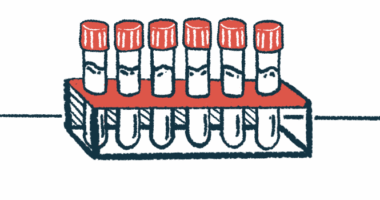COYA 302 slows disease progression, lowers biomarkers: Trial
Phase 1 study tested therapy in four ALS patients

COYA 302, Coya Therapeutics’ experimental immune-modulating combination therapy, safely slows disease progression and reduces levels of disease biomarkers in people with amyotrophic lateral sclerosis (ALS).
That’s according to the now-published results from a small proof-of-concept Phase 1 clinical trial (NCT06307301) that tested the therapy in four ALS patients.
The trial’s findings were published in the study, “A phase 1 proof-of-concept study evaluating safety, tolerability, and biological marker responses with combination therapy of CTLA4-Ig and interleukin-2 in amyotrophic lateral sclerosis,” published in Frontiers in Neurology.
“This publication illustrates a promising clinical signal of a novel biologic combination immunotherapy in ALS, a truly devastating condition with high unmet need,” Howard H. Berman, PhD, Coya’s CEO, said in a company press release.
Coya in January reached an agreement with the U.S. Food and Drug Administration (FDA) regarding manufacturing, preclinical research, and clinical studies of COYA 302. Berman said the company remains on track to submit an investigational new drug application with the FDA later this month seeking clearance to conduct a placebo-controlled trial.
Targeting immune cells
ALS is characterized by progressive damage and death of motor neurons, the nerve cells that control voluntary movements. While the exact cause of the disease remains largely unclear, several processes are thought to be major contributors, including neuroinflammation and a type of cellular damage called oxidative stress.
COYA 302, administered via under-the-skin injections, combines a low dose of the immune signaling molecule interleukin-2 (IL-2) with a fusion protein called CTLA4-Ig (sold as Abatacept for treating certain autoimmune conditions).
IL-2 is intended to ease inflammation by boosting the activity of regulatory T-cells (Tregs), a type of inflammation-suppressing immune cell. At the same time, CTLA4-Ig is expected to decrease the activity of pro-inflammatory immune cells.
The proof-of-concept study enrolled four adult ALS patients at Houston Methodist Research Institute. All were experiencing declines in their ability to perform daily tasks, as indicated by a mean 1.1-point loss per month in the ALS Functional Rating Scale (ALSFRS-R).
Three participants had sporadic ALS, and one carried a C9ORF72 mutation, the most common genetic cause of ALS. Three patients had impaired lung function and were being treated with non-invasive breathing support.
The participants received 24 treatment cycles over 48 weeks, and were followed for nearly two months after stopping COYA 302 treatment.
During the first 24 weeks (nearly six months), patients’ ability to perform daily activities remained stable, as reflected by an increase of 0.04 points per month in the ALSFRS-R score, on average.
ALSFRS-R scores improved in two patients and another’s score was unchanged. The fourth patient experienced a four-point decline at week four, but remained relatively stable until week 24.
As previously reported, after nearly one year of treatment, the ALSFRS-R score declined by 0.13 points per month on average. After excluding one patient who saw an 11-point ALSFRS-R rise, indicating a considerable functional improvement, the remaining three patients experienced an average decline of 0.47 points per month, which was still below the 1.1-point monthly loss before treatment, the researchers noted.
Treg’s anti-inflammatory function was significantly enhanced at weeks 16, 24, and 48, but returned to pre-treatment levels after stopping COYA 302, “suggesting enhanced and durable Treg suppressive function over the course of treatment,” Coya said.
All patients with higher-than-normal levels of ox-LDL and lipid peroxide 4-HNE, two markers of oxidative stress; a pro-inflammatory molecule called IL-18; or a nerve damage marker caller neurofilament light chain showed trends of decline in these levels after 16 weeks of treatment.
Disease progression stopped for 24 weeks
“The ability of the combination therapy to halt clinical progression in ALS for 24 weeks provides an important proof of concept for the protective role of Tregs while simultaneously suppressing inflammation,” said Stanley Appel, MD, the study’s senior author and director of the Ann Kimball & John W. Johnson Center for Cellular Therapeutics at Houston Methodist Hospital. “What is most gratifying is the concomitant reduction of the lipid peroxide 4-HNE as well as inflammatory [molecules].”
The combination therapy was generally well tolerated, with all adverse events being mild and without reports of serious adverse events. One patient had persistent injection site reactions, and two experienced falls, which are commonly related to ALS progression.
Two patients contracted COVID-19 infections while on COYA 302. These resolved without treatment, suggesting no impairment of immune responses due to COYA 302.
The findings suggest that “the combination therapy of CTLA4-Ig and IL-2 in ALS is safe and well-tolerated with promising results of clinical efficacy and suppression of biomarkers of oxidative stress, neuroinflammation and neuronal degeneration,” the researchers wrote.
Appel said the study “provides the basis for a large-scale double-blind placebo-controlled trial to establish potential therapeutic efficacy for ALS patients.”
“The goal of future studies is to determine whether optimized doses of CTLA4-Ig/IL-2 slow disease progression, and whether there are populations of patients with specific patterns of biological markers that respond more favorably to immunomodulatory treatment,” the researchers said.








